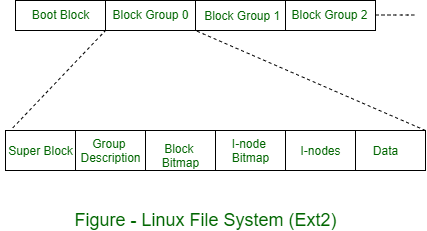Compare file system in Windows and Linux
Last Updated :
01 Feb, 2022
File System in Linux :
Linux supports more than 12 file systems with NFS technology. When Linux (that is, operating system code) is linked, the default file system option needs to be specified. other file systems can be called dynamically depending on requirements. Ext file system is the most popular option. It is similar to the Berkeley file system.
This file system assumes that the disk begins with a boot block and then the disk is created from a series of other blockgroups. Block groups are numbered sequentially, and contain several subfields.
The overall organization is shown in figure.

The details of the sub-fields in a block group are as follows-
- Super Block – Specifies the number of blocks, the number of i-nodes, block size etc.
- Group Description – Contains information about the bitmap location, number of free blocks, i-nodes, directories in the group, etc.
- Block Bitmap – Contains a list of free blocks.
- I-node Bitmap – Contains a list of free I-nodes.
- I-nodes – These are the actual i-nodes. Each I-node is 128 byte long.
Linux supports the following file types-
- Directory – This is simply a list of names.
- Ordinary File – This is a file containing data or application program or executable.
- Symbolic Link – This file is actually a link to (or path of) another file.
- Special File – This refers to a device driver.
- Named pipe – This is a common channel between two or more processes for data exchange.
File System in Windows :- Windows 2000 (W2K) supports a number of file systems including the file allocation table (FAT) that runs on Windows 95, MS-DOS and OS/2. But the developers of W@K also designed a new file system, the W2K file system (NTFS), that is intended to meet high-end requirements for workstations and servers.
Examples of high-end applications include the following-
- Client/server applications such as file servers, computer servers and database servers.
- Resource-intensive engineering and scientific applications.
- Network applications for large corporate systems.
Key Features of NTFS :
NTFS is a flexible and powerful file system, built on a simple file system model. The most notable features of NTFS include the following-
- Recoverability
- Security
- Large disks and large files
- Multiple data streams
- General Indexing Facility
NTFS Volume and File Structure :
NTFS makes use of the following disk storage concepts-
- Sector :
The smallest physical storage unit on the disk. The data size in bytes is a power of 2 and is almost always 512 bytes.
- Cluster :
One or more contiguous (next to each other on the same track) sectors. The cluster size in sectors is a power of 2.
- Volume :
A logical partition on a disk, consisting of one or more clusters and used by a file system to allocate space. At any time, a volume consists of a file system information, a collection of files, and any additional unallocated space remaining on the volume that can be allocated to files. A volume can be all or a portion of a single disk or it can extend across multiple disks. If hardware or software RAID 5 is employed, a volume consists of stripes spanning multiple disks.
Like Article
Suggest improvement
Share your thoughts in the comments
Please Login to comment...